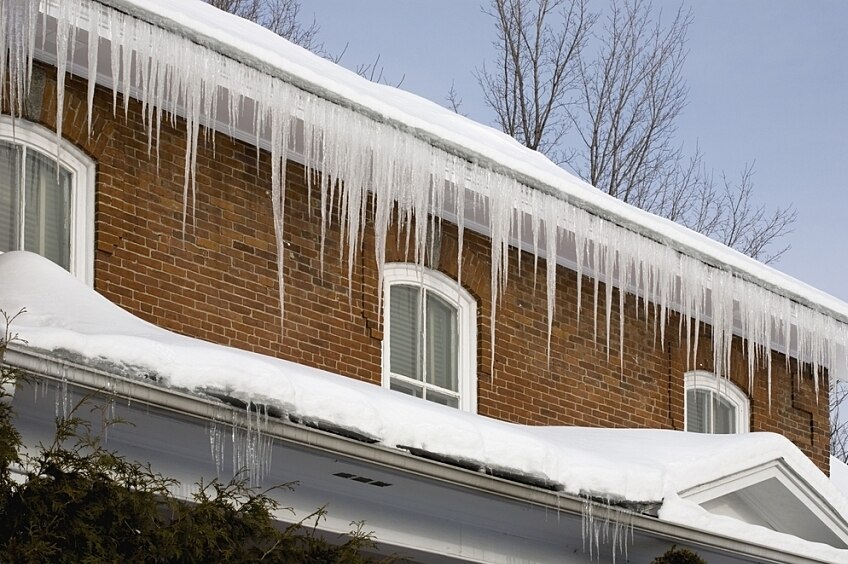An ice dam at the edge of a roof can create beautiful icicles—however, those icicles turn ugly quickly when they damage your roof or home. To keep these icy dangers at bay, here's your primer on what ice dams are, the steps that you can take to safely remove them, and how you can prevent new ones from forming in the first place.
What are ice dams?
An ice dam is a buildup of ice at the edge of a roof that prevents melted water from draining off the roof. When that melted water backs up behind the dam, it can work its way under the roof shingles, infiltrating your home and damaging ceilings, walls, and insulation.
What causes ice dams to form?
If snow collects on a roof with uneven surface temperatures, it may form ice dams. This happens when the steeper parts of the roof are warmer than the lower edges: the warmer temperatures cause the snow on the upper part to melt. As the water trickles down to the lower, colder portion of the roof it refreezes. This is called a freeze-thaw cycle, which creates a dam that prevents any water from exiting the roof.
What makes the roof surface temperature uneven?
Heating your home in the winter introduces warm air, which then rises and makes its way into the attic space. Particularly when attic ventilation is poor, the heated air builds up in the higher portions of the attic, warming the surface of the upper part of the roof. An effective attic ventilation system allows cold air to enter the attic through soffit or intake vents so that it can force the warm air out of the attic through the exhaust vents. This, in turn, helps to keep the temperature of the attic similar to the ambient temperature outside.
How can I help reduce the risk of ice dams?
Where there is a threat of ice damming, most building codes require installing leak barriers at the lower horizontal edges of the roof, also known as the eaves. Leak barriers can help prevent leaks caused by wind driven rain and ice dams by creating a barrier at the most vulnerable sections of the roof. If your home is in the north, leak barriers at the eaves may be required for certain warranty coverage. Having a balanced and effective attic ventilation system can also help to reduce the risk of ice dams before they can occur. GAF Cobra®and Master Flow® Attic Ventilation Products offer a complete line of attic ventilation solutions.
What should I do if I have an ice dam?
It is recommended to reach out to a roofing professional to safely remove any ice dams. The first step they will take is to remove the snow. An extendable snow rake can help to gently scrape any snow off of the roof. They may also use a soft mallet to break up ice in small sections at a time, which could cause the ice to crack off in large chunks that crash down. It is important to remove snow and ice safely and effectively without risking damage to the roof or other parts of your property, such as gutters, windows, siding or landscaping. You can find a qualified roofing professional to safely remove ice dams by entering your location in GAF's contractor locator.
What should I do if I have ice in my gutters?
If your gutters have ice in them, the best course of action may be to simply wait it out until nature melts the ice. It's easy to accidentally damage gutters or your roof while attempting to break up the ice. Be sure to keep a careful eye on the frozen gutters, and check the corresponding interior spaces inside your home for water intrusion. If you spot a leak, contact a professional to resolve the issue.
How can the right roofing system help prevent ice dams?
If you're in an area of the country that experiences snow in the winter, you should feel confident that your roofing system includes the proper protection—starting with the underlayment that covers the roof deck. Using a leak barrier product such as GAF Weatherwatch® or Stormguard® can help prevent leaks caused by ice dams. Your local contractor certified by GAF can make a recommendation after evaluating your ventilation, your attic insulation, and the style of roof shingles that you choose for your roofing project.
Don't ignore those icicles that form after a snowstorm. They're not decorations—instead, they may indicate potentially more serious roofing problems. Reaching out to a professional roofing contractor could prevent major damage to your home

